Sleep tight: A curious history of beds through the centuries
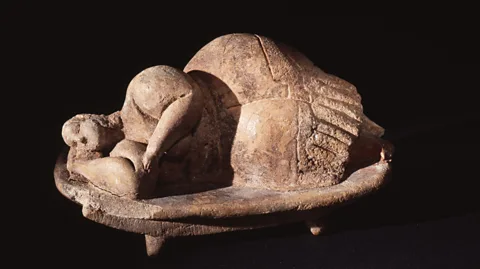 Getty Images
Getty ImagesFrom beds for Roman newlyweds, to "hangover" benches for 19th-Century workers: the pursuit of a good night's sleep has followed us through the ages.
Amid the windswept expanse of the Bay of Skaill, on the west coast of the Scottish island of Orkney, is the ancient village of Skara Brae. This maze of fuzzy green mounds – large, single-room houses surrounded by thick walls topped with grass and connected with covered stone passageways – was abandoned some four and a half thousand years ago. But inside each residence are two objects that still look familiar to modern eyes – beds.
The dwellings at Skara Brae, in the far north of Scotland, mostly have the same setup – a roughly 40 sq m (430 sq ft) room with a central hearth and an assortment of prehistoric furniture. Alongside storage boxes and dressing tables complete with shelves, there are two rectangular enclosures, around the length of a human. Like most of the artefacts found on this tree-less island, these prehistoric beds are made from slabs of cold, hard stone. And yet, with tall headboards and raised sides, they have an instantly recognisable shape. Setting aside the ancient inscriptions found on some – and the occasional skeleton stashed underneath – perhaps they could almost belong to the 21st Century.
Humans have been making beds for hundreds of thousands of years. In the book What we did in bed: a horizontal history, the University of California, Santa Barbara anthropologist Brian Fagan and archaeologist Nadia Durrani chart their development from the very beginning. For most of our species' existence, it's thought that sleeping spaces consisted of deep piles of carefully layered foliage topped with soft, pest-resistant leaves. Then the first bed frames began to appear. The sandstone beds at Skara Brae are among the oldest ever found, along with a series of impressions left in the soil at the settlement of Durrington Walls near Stonehenge – the spectral outlines of long-vanished wooden bed boxes, where the builders of that monument may have once slept.
Emerging just over 5,000 years ago, not long after other pioneering technologies such as writing, bed frames appeared in several places at around the same time. Some 1,700 miles (2,735km) from Orkney, in Malta, ritualised burial tunnels have revealed evidence of early incarnations of this furniture – including a clay figurine of a woman slumbering peacefully on her side, one hand under her head, on a simple raised platform. These early beds were not just places to rest. They often held deep symbolic meanings and links to the afterlife, according to Fagan and Durrani.
In the millennia since, the bed has evolved to take on many different forms – reflecting the beliefs and practical concerns of the cultures that people have found themselves in. Here is a short history of these temples of sleep, at least in the Western world.
 Alamy
AlamyAncient Egypt – headrests and sleeping platforms
When Howard Carter broke through the plaster doorway into King Tutankhamun's tomb in 1922, he was greeted with a glittering hoard of gold objects – and six of these items were beds. The haphazard assortment of items, which had been thrown back in randomly after two ancient robberies, included a funerary bed decorated with the likeness of the cow goddess Mehet-weret, a gilded wooden bed, and a practical camp bed for travelling that featured revolutionary folding technology and may have been the first of its kind.
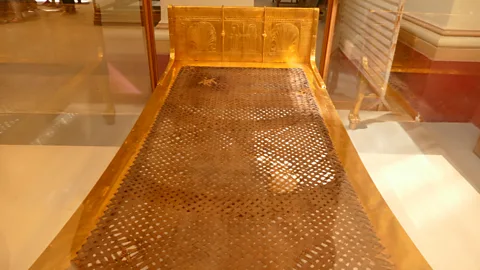 Getty Images
Getty ImagesLike most ancient Egyptian beds made for wealthy elites, Tutankhamun's mostly consist of a wooden frame with a woven base of reeds or string. And as was customary at the time, the young king would have laid his sleepy head on a rigid, raised headrest each night rather than a soft pillow. This system was often found in hot climates, where it may have improved the circulation of air. It could also have been appealing as a way of protecting carefully coiffured hairstyles – the ancient Egyptians, including Tutankhamun's own grandmother, sometimes wore curled, braided, or plaited styles.
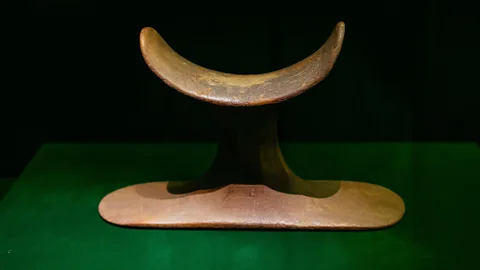 Alamy
AlamyAncient Rome – a bed for every occasion
In ancient Rome, as in many societies, where people slept depended on their social status. While some slaves may have tucked themselves up each night on a mat of dried leaves or animal skins, or just curled up on the bare ground, others were more comfortable. In 2021, archaeologists were excavating the grounds of an ancient villa in Civita Giuliana, a suburb of the Roman city of Pompeii, when they uncovered a bedroom that had remained frozen in time for almost 2,000 years. Among a clutter of containers, wooden chests, and other items, there were three beds – and underneath, storage jars containing the remains of mice that had been living under them. Made of wooden posts strung with thin rope arranged like netting, they didn't have mattresses and were instead covered with loose blankets.
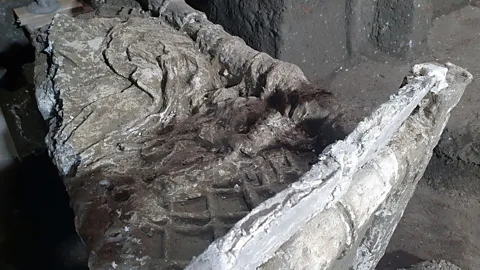 Alamy
AlamyOn the other hand, affluent citizens had more beds than they knew what to do with. The Romans invented a wide taxonomy of different kinds of bed for various different activities, including the lectus lucubratorius for studying, the lectus genialis for newlywed couples, the lectus tricliniaris for communal lounging and eating, and the lectus cubicularis for sleeping. They even had a dedicated bed for funerals. Most of these beds consisted of a raised platform made of metal, topped with a thin mattress.
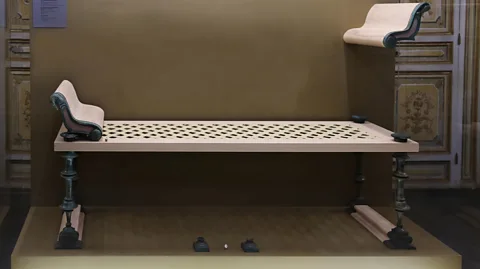 Alamy
AlamyEarly modern Europe – bed bugs and thick mattresses
By the 17th Century, Europeans had a wide universe of beds to choose from. There were box beds (Read more from BBC Future about why medieval people slept in cupboards), beds strung with rope – which had to be tightened regularly, possibly leading to the expression "sleep tight" – and elaborate wooden four-posted beds like the Great Bed of Ware, which reportedly once slept 52 people. But one staple ingredient of early modern bedding was the "tick mattress".
These simple sacks, which sometimes reached gigantic proportions, were made of strong, tightly woven materials such as linen, known as "ticking". They could be stuffed with a wide variety of fillings, from feathers to straw. The specific packing material used could have a profound impact on the inhabitant's quality of sleep. According to the book At Day's Close: A History of Nighttime, one traveller passing through Switzerland in 1646 complained bitterly about having to spend the night in a bed stuffed with leaves, which "made such a crackling" and pricked his skin through the tick.
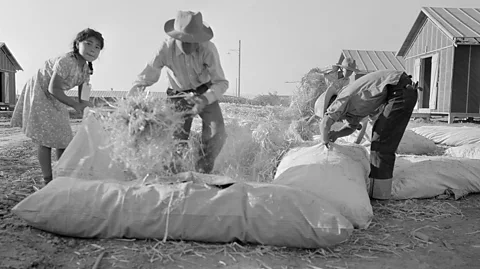 Alamy
AlamyThough tick mattresses were – or at least they were supposed to be – aired regularly, they were ideal breeding grounds for biting insects. Combined with the then-common habit of sharing a bed with many other people, including total strangers, they often ended up with formidable infestations. (Read more from BBC Future about the lost ancient habit of communal sleep.)
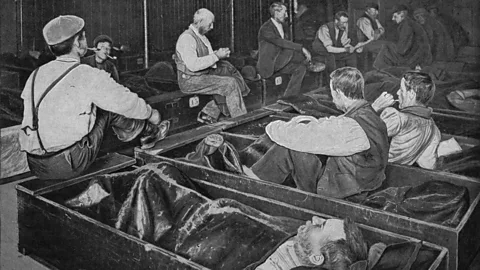 Getty Images
Getty ImagesVictorian England – hangovers and homelessness
By the 19th Century, inequality in England had reached a record high, as the working classes struggled to earn a living in the new industrialised economy. This, combined with the rapidly growing population, led to an epidemic of homelessness in towns and cities. In London, charities came up with some unorthodox solutions. One was the "fourpenny coffin" – coffin-shaped boxes, arranged in rows, that people could pay fourpence to sleep in for the night. Another was the rope-bed, also known as the "two-penny hangover", which involved sitting on a communal bench and leaning over onto a long rope, along with hundreds of other people, until the morning when it was cut – abruptly waking anyone who was still sleeping. This is one possible explanation for the origins of the word "hangover".
For those at the other end of the financial spectrum, however, sleep was about to get significantly better. In the late 1800s a German inventor filed the patent for the first coil-sprung mattress – and sleep has never been the same since. Today there are more options than ever, with foam beds, water beds, heated beds, futons, bunk beds, Ottoman beds, canopy beds… the list goes on. We can only wonder what the inhabitants of Skara Brae would have made of them.
--
If you liked this story, sign up for The Essential List newsletter – a handpicked selection of features, videos and can't-miss news delivered to your inbox every Friday.
